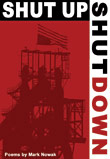Woven Voices: Mark Nowak’s “Shut Up Shut Down”
Erin Lynn Marsh reviews Mark Nowak's book "Shut Up Shut Down," published by Coffee House.

As a poet, I often feel as though I “should” have something intelligent to say about every poetry collection I come in contact with. My mind takes an image and, through a thick maze of associations, puts it into words – so I should be able to understand the inner workings of other poets’ minds as well, right? Well, no. More often that I would like to admit, I come across a poetry collection that literally stuns me, leaves me shaken and unsure about the nature of poetry itself. Such is the case with Mark Nowak’s second collection, Shut Up Shut Down (Coffee House Press, $15.00).
The book is comprised of five long series, three of which are ekphrastic explorations of the correlation of the destruction and decay of factories/plants and the treatment of workers as expendable by the powers that be. Many of the poems in this collection contain multiple voices, which could be jarring, but instead create a sense of place in both the historical and physical realms. The following poem, from the section titled “$00/LINE/STEEL/TRAIN”, is a wonderful example of Nowak’s multi-voiced approach and a fine representative of the layout and style of the entire section:
215.
Read the writing on the Wal-Mart. The town has never been the same,
says Frank Albert, 71 . . . whose home fell to the bulldozers. In the U.S.
Steel Gary Works yard, someone spray-painted “House of Pain” on an
empty coal car. We lost a lot of people when the West Side went. There
just weren’t enough homes for those who wanted to stay. Under the
(Capital) cover of darkness the “HALT!” signs go unread. Albert is still
president of the West Side Co., the volunteer fire department of
a neighborhood that no longer exists. Doors (scrape), doors (stain),
doors (including or only their frames). We still have meetings, he says.
B
*
How this photograph is
How the frame
Became
,bR>
{consumption}
How the Other Half Lives
The titles of all the poems in this series are numbers that correlate to photographs from Bernd and Hilla Becher’s Industrial Facades. The words in bold are like those found in a newspaper report (if you look at Nowak’s extensive “Works Cited” lists, you will find newspaper reports), distant and objective. The non-bold lines are those of an omniscient narrator. Lastly, there are the cloud-like lines of the second stanza. These lines act as a sort of sketchy summary of the preceding prose.
Another multi-voiced series in the book is “Capitalization”, which combines excerpts from Margaret Shertzer’s The Elements of Grammar, newspaper excerpts on Reagan’s firing of striking air traffic controllers in the 80’s, and a first-person account of union building/destruction during the McCarthy era. The addition of the excerpts from the grammar book adds an element of prophecy and irony, as is illustrated in the following extraction from the third poem in the series:
Do not capitalize the following
when they stand alone: judge, justice
Capitalize President
Captitalize Vice President
Capitalize Senator, Conressman
Capitalize Speaker
Capitalize Governor, Mayor, Cardinal
That “here” was located at some imaginary point
between General Electric itself and your living room.
But unlike more recent TV pitchmen,
such as Lee Iacocca and Frank Perdue,
Reagan was never burdened
with the pretense that he was himself
part of the actual production.
Reading Nowak’s Shut Up Shut Down left me reeling, pondering the use of many voices and many sources in the act of writing poetry. Nowak shows us that in tracing the development of the labour movement, we must extract voices from the past and lay them out plainly for investigation.
Erin Lynn Marsh is pursuing her MFA at Lesley University’s low-residency program and lives/writes in Minneapolis.